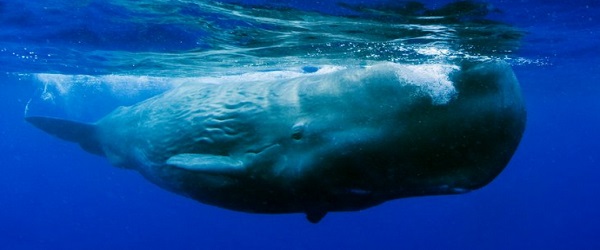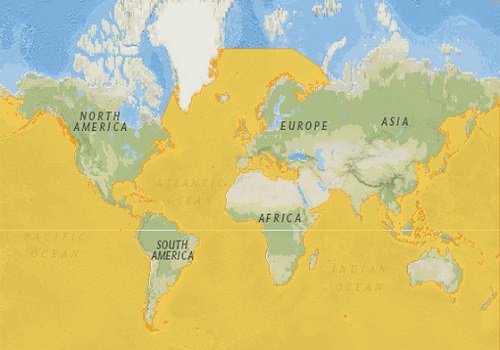Name
- Common name: Sperm Whale, Spermacet Whale, Cachelot, Pot Whale. “Spermaceti”, the organ in the head of the whale which contains an oily liquid once believed to be sperm.
- Scientific name: Physeter macrocephalus. Physeter is derived from the Greek word for “blowpipe or blowhole” Macrocephalus is derived from Greek meaning “big head”.
Conservation Status
- The sperm whale is classified by the IUCN as a Vulnerable species.
- It is listed in CITES Appendix I.
- The International Whaling Commission manages sperm whale populations.
Distribution and Habitat
- This marine mammal is distributed in all the oceans including enclosed or partially enclosed seas such as the Mediterranean Sea, Sea of Okhotsk and the Gulf of Mexico. Exceptions are the Black Sea and the Red Sea.
- Its habitat is the open sea in waters deeper than 1,000 meters that are not covered by ice.
- Male and female adults have different distributions. Females prefer warmer waters above 15˚C within 40˚ N and 40˚ S latitude. Males prefer higher latitudes. Males migrate in the spring to lower latitudes to breed.
o
Physical Features
- Its head makes up 25 to 30% of its entire length. It contains the spermaceti organ. Scientists are still not certain about its function but they believe that it is used in the emission of sound for echolocation.
- It was once believed that the oily fluid in the spermaceti was sperm.
- Its brain is the largest of any living creature on earth.
- The blowhole is S-shaped and is skewed to the left side of the head.
- Its skin is black to dark grown or grey with white areas in the belly and around the mouth. The skin on its back is wrinkled.
- Sperm whales are toothed whales.
- They have a thick layer of blubber to protect them from freezing temperatures. The bubbler is approximately 13.7 inches (35 cm) thick.
- Instead of a dorsal fin they have a hump and longitudinal ridges.
- Its pectoral fins are small around 79 inches (2 m) long. Its tail flukes are long and triangular and measure around 13 to 14.7 feet (4 to 4.5 meters) long.
Size and Weight
- There is a large sexual dimorphism between males and females.
- Males are much larger. Their body length ranges from 52.5 to 59 inches (16 to 18 meters) and weigh from 99,208 to 125,664 lb (45,000 to 57,000 kg).
- Females reach an average of 36 inches (11 meters) in length and weigh 15,000 kg.
Behavior
- Sperm whales live in groups called pods of 15 to 20 individuals which include females with their calves. Males are solitary or move from pod to pod.
- Females and their calves stay in tropical or subtropical water all year long.
- Males migrate to higher latitudes and return to tropical waters to breed.
- Sperm whales can dive as deep as 3,280 feet (1,000 meters).
- They can hold their breaths for up to 90 minutes.
- Like dolphins, the sperm whale uses echolocation to determine location, size and distance of an object or prey. They send loud clicks under water, the sound bounces back to the whale to interpret the echo.
Diet
- These toothed whales are carnivore and eat around 2,000 lb (907 kg) of squid, octopus and fish per day.
Reproduction
- Females reach reproductive maturity at 7 to 13 years old while males in their late 20s.
- Breeding peaks in the spring when males migrate to the equator in order to find breeding partners.
- Female sperm whales give birth every 4 to 6 years. Females over 40 very rarely get pregnant.
- Gestation lasts from 14 to 16 months.
Life Expectancy
- Maximum life expectancy in the wild is 77 years.
Threats
- The greatest threats facing sperm whales is commercial whaling.
- Entanglement in fishing nets.
- Low fertility rate, 1% population increase per year.
- Collisions with ships.
- Pollution of the seas.
Taxonomy
- Kingdom: Animalia
- Phylum: Chordata
- Class: Mammalia
- Order: Cetartiodactyla
- Family: Physeteridae
- Genus: Physeter
- Species: Physeter macrocephalus
References and further research
World Register of Marine Species – Physerter macrosephalus, Linnaeus 1758
Australian Government Department of the Environment – Physeter macrocephalus Sperm Whale
Smithsonian National Museum of Natural History Physeter macrocephalus Sperm Whale
Convention on the Conservation of Migratory Species of Wild Animals – Physeter macrocephalus
Marine Species Identification Portal – Physeter macrocephalus
Whale and Dolphin Conservation – Physeter macrocephalus
IUCN Red List of Threatened Species – Physeter macrocephalus
National Oceanic and Atmospheric Administration – Physeter macrocephalus


